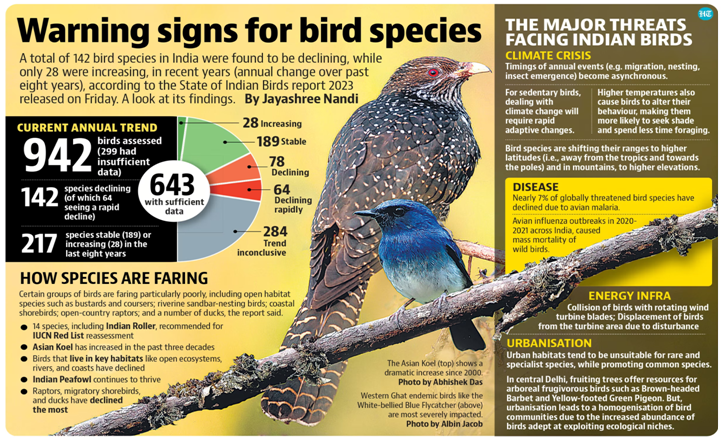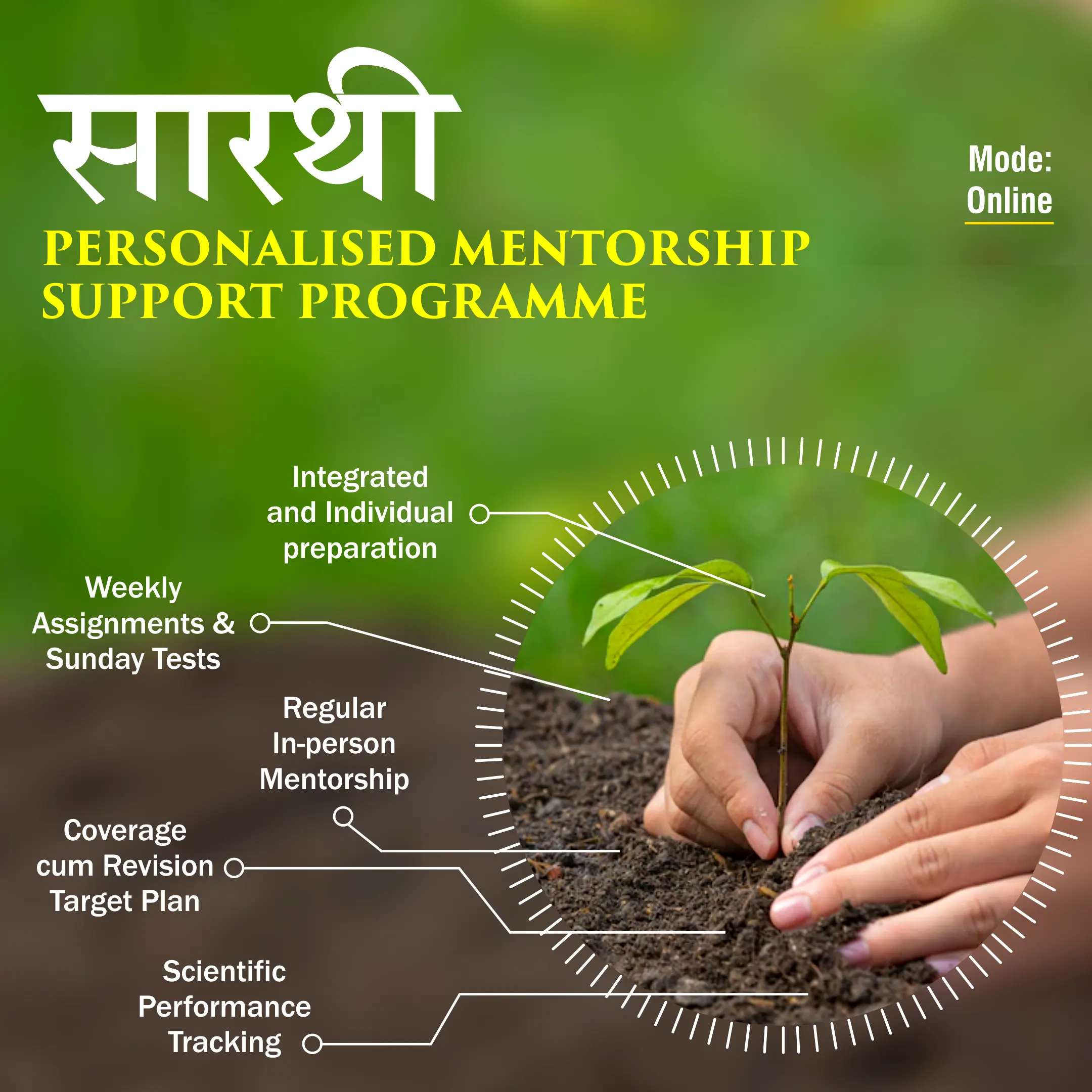
Disclaimer: Copyright infringement not intended.
Context
- Coimbatore-based start-up AR4 Tech has announced a strategic partnership with Singapore's Sodion Energy to produce sodium ion battery packs for both the domestic and export markets.
- The collaboration aims to leverage Sodion Energy's expertise in sodium-ion battery technology and AR4 Tech's manufacturing capabilities.
Details
The "State of India’s Birds (SoIB) 2023" Report is a significant assessment of bird species in India, aimed at understanding their conservation status. Here are some key details about the report:
Purpose and Scope
- The report was created to assess the conservation status of a wide range of bird species regularly found in India.
- It aims to address the lack of comprehensive information on the status of various bird species in the country.
Publishers
- The SoIB report is published by the State of India’s Birds Partnership, which is a collaboration of 13 organizations including both governmental (such as SACON, WII, ZSI) and non-governmental organizations.
Focus on Common Species
- Globally, there's a trend of declining common and widespread species, but in India, conservation efforts have often been focused on a few charismatic and threatened species due to limited information.
- The report seeks to broaden the focus to include a broader array of species.
Data Sources
- The report utilizes a massive dataset comprising over 30 million bird observations contributed by more than 30,000 birdwatchers to the eBird platform.
- This wealth of data enabled the evaluation of distribution range size and trends in abundance of 942 Indian bird species.
Assessment Criteria
- The report evaluates species based on three main measures: distribution range size, long-term abundance trends (over 25+ years), and current abundance trends (since 2015).
- Information from the IUCN Red List of global threat status is also considered.
- Based on these criteria, the report categorizes species into Low, Moderate, and High categories of Conservation Priority for India.

Key points from the report
General Decline in Bird Numbers
- The report indicates a widespread decline in the numbers of most bird species across India.
- Raptors, migratory shorebirds, and ducks are among the groups that have experienced significant declines.
- Factors contributing to these declines include habitat loss, pollution, agrochemicals, and disturbances.
Positive Trends
- Despite the overall decline, several bird species have shown positive trends in terms of both abundance and distribution.
- Species such as the Indian Peafowl, Rock Pigeon, Asian Koel, and House Crow are exhibiting an "increasing trend."
Indian Peafowl's Success
- The Indian Peafowl, India's national bird, is rapidly increasing in population and distribution.
- Peafowls are expanding into new habitats, including high-altitude areas like the Himalayas and rainforests in the Western Ghats.
- Population density is also on the rise in areas where peafowls were already present.
Asian Koel and Others
- The Asian Koel has experienced a substantial increase in abundance by 75%, with an annual current increase of 2.7% per year.
- Other species like the House Crow, Rock Pigeon, and Alexandrine Parakeet are also doing well in terms of abundance.
Specialist vs. Generalist Species
- Birds specialized to specific habitats like wetlands and rainforests (specialists) are declining rapidly.
- Birds with a broader habitat range (generalists) are faring relatively better, emphasizing the importance of habitat preservation.
Conservation Priorities
- The report categorizes bird species based on conservation priority.
- Birds that have experienced considerable declines over time are labeled as high-priority species.
- Species with moderate and low conservation priorities are also identified.
- The report highlights that a significant number of species, previously assumed to be common and widespread, are actually of High Conservation Priority.
- This underscores the importance of reevaluating conservation efforts to address the needs of a broader range of species.
- The SoIB 2023 Report aims to provide a comprehensive understanding of the status of various bird species in India, ensuring that conservation strategies can be targeted effectively across a wider spectrum of species to promote their survival and well-being.
Dietary Requirements and Abundance Trends
- Birds that feed on vertebrates and carrion have declined, indicating potential contamination in their food resources.
- Birds feeding on invertebrates, fruits, and nectar are faring better.
Endemic and Vulnerable Species
- Bird species endemic to specific regions, like the Western Ghats, have declined over the years.
- Some endemic species have experienced significant long-term declines.
Conservation Imperative
- The report highlights the urgency of continued conservation efforts to address the decline in bird populations.
- Habitat preservation, reduced pollution, and better management of threats are key strategies for bird conservation.
Key threats identified in the report
- Threats such as habitat loss, pollution, agrochemicals, and disturbances are impacting bird populations.
- The decline of specialists, including grassland and woodland specialists, underscores the need to protect and conserve their specific habitats.
- Migratory species, especially long-distance migrants, are facing significant declines.
Climate Change
- Climate change disrupts bird species interactions through phenological mismatches, causing breeding, nesting, and migration to be out of sync with available resources.
- Rising temperatures force birds to adapt rapidly, altering their behavior and habitat preferences.
- Climate change leads to new interactions between species, affecting survival and reproduction.
Urbanisation
- Urban areas have fewer bird species due to habitat loss, exposure to air pollution, and high temperatures.
- Noise pollution in cities can lead to changes in bird songs, while light pollution may disorient birds and cause collisions with buildings.
- Dominant species like House Crows and Rock Pigeons thrive in urban areas, leading to a lack of diversity.
Monocultures
- Commercial monoculture plantations of crops like rubber, tea, and oil palm reduce bird diversity compared to natural forests.
- Plantations provide limited habitat and resources for bird species.
Energy Infrastructure
- Renewable energy sources like wind turbines and power transmission lines pose threats to birds.
- Birds collide with wind turbines, causing fatalities.
- Power transmission lines lead to collisions and electrocution of birds, affecting a wide range of species.
Habitat Degradation
- Ecosystem degradation, including deforestation and habitat fragmentation, reduces suitable habitats for birds.
- Birds specialized in specific habitats, like grasslands and wetlands, are particularly affected.
Environmental Pollutants
- Pollution from pesticides and other chemicals affects bird health and reproduction.
- Pollutants can enter the food chain and impact bird populations.
Human Disturbances
- Disturbances from human activities, such as tourism and construction, disrupt nesting and feeding behaviors of birds.
Overexploitation and Hunting
- Hunting and illegal trade of birds for their feathers, eggs, and body parts threaten some species.
Invasive Species
- Introduction of non-native species can disrupt native ecosystems and impact bird populations.

Conclusion
Overall, while the report raises concerns about the declining numbers of many bird species in India, it also provides insights into the positive trends and success stories of certain species. This comprehensive assessment serves as a valuable resource for conservation efforts aimed at protecting India's diverse avian populations.
|
PRACTICE QUESTION
Q. What are the key findings and threats identified in the 'State of India’s Birds (SoIB) 2023' report, and how does it contribute to enhancing bird conservation efforts? (250 Words)
|
https://indianexpress.com/article/india/state-of-birds-most-species-show-dip-indian-peafowl-among-those-flourishing-8909776/




